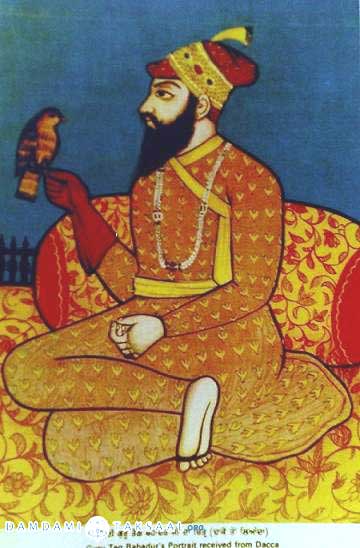
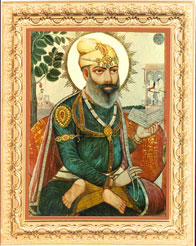
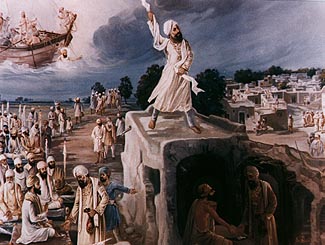
I HAVE FOUND THE GURU
On finding his ship, full of rich merchandise, sinking, Bhai Makhan Shah Lubana prayed that if his ship survived he would offer a certain amount to the Guru. But when he came to Baba Bakala to make the offering, he found that there were too many claimants to guruship. Presuming that the Real Guru would himself know and question him tto make the promised offering, he went around placing two coins before each one of them. When the ninth Guru asked for the promised offer, Bhai Makhan Shah (above) went to the top of the roof and declared,
"Come all ye followers of the Guru, I have found Him!"
Like his predecessors since the days of Guru Hargobind, Guru Tegh Bahadur maintained the marks of worldly dignity. But he lived austerely. Aurangzeb was persecuting the Hindus. Some Kashmiri Pandits came to seek the Guru's advice at Anandpur. The Guru readily agreed to sacrifice himself for the sake of their faith. Accordingly a message was sent to the emperor that if Guru Tegh Bahadur accepted Islam, they would follow suit. Aurangzeb had the Guru arrested near Ropar and kept as prisoner at Bassi Pathana with his companions Bhai Mati Das, Bhai Sati Das and Bhai Dayala for nearly four months. He was then brought to Delhi and on his refusal to accept Islam was executed in 1675 AD at a place where now stands the famous Gurdwara Sis Ganj. Bhai Jaita a devout Sikh took the head to Anandpur. Lakhi Shah, a Lubana Sikh, helped by his son carried the headless body in their cart to their home and cremated it by setting fire to their house. At that place in Delhi now stands the famous Gurdwara Rakab Ganj at a stone's throw from the Rashtrapati Bhawan and the Parliament House. The martyrdom was no small happening. It was something of immense magnitude and of immense consequence. A most sensitive and comprehensive genius of the age had undertaken to answer the time with all his moral strength.
Guru Tegh Bahadur was a prolific writer. 115 of his hymns are included in the Adi Granth.
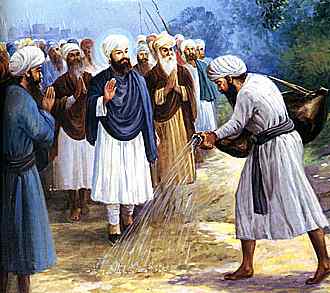
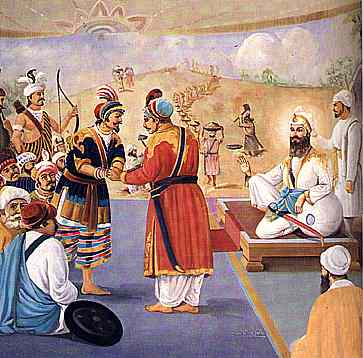
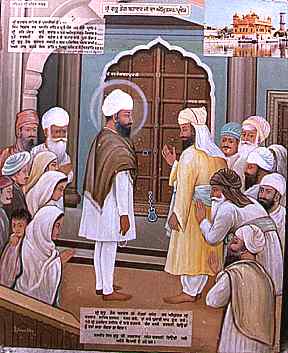

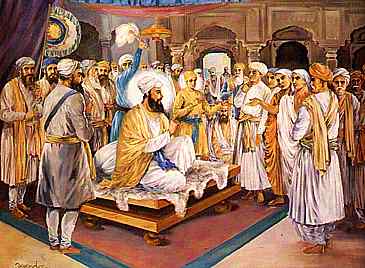
THE MARTYRDOM of GURU TEG BAHADUR - Hind di Chadar

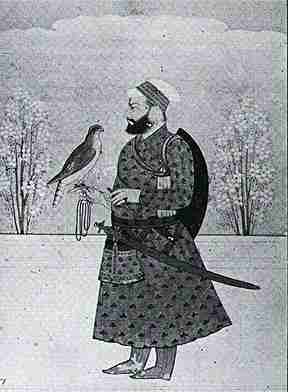
Guru Teg bahadur - a painting from the Lahore Museum (courtesy F. Aijazzudin)
Guru Teg Bahadur stands against a pale-blue background, holds a falcon on his right hand. He is sumptously dressed in a gold 'jama' decorated with a clover-leaf motif. A black shield, embellished with gold, is slung across his back.
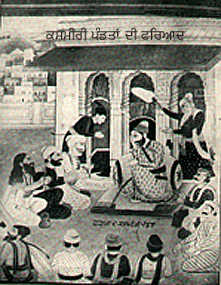
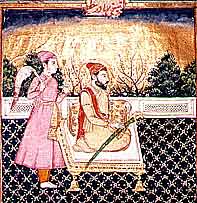
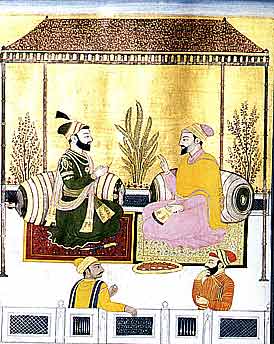
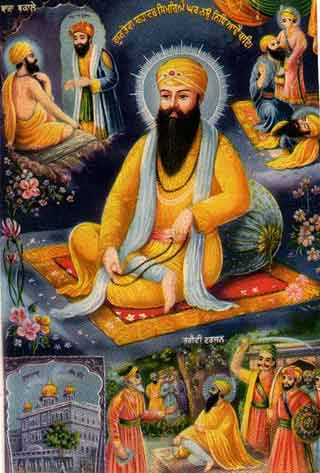
GURU TEG BAHADUR (1664-75)
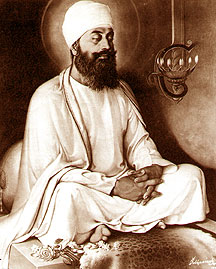
Teg Bahadur, the ninth Guru, was the second of the Gurus to be martyred. Sikh
tradition attributes his death to the bigotry of the sixth Mughal emperor, Aurangzeb
(1659-1707). It is not seen,however, as the result of a direct attack on the Panth
or its leader. The tradition affirms that it resulted from Aurangzeb's hostility
towards all non-Muslims, and specifically from an attempt to convert the Hindus
of Kashmir to Islam. Gian Singh provides a detailed version of the tradition in
his Tavarikh Guru Khalsa (1.7 [8]). He records how the Brahmans of Kashmir, confronted
by the fearsome threats of the Mughal governor, had gathered at the temple of
Amarnath and were preparing to face death rather than conversion. Suddenly there
appeared before them a sadhu who urged them to seek the protection of Guru Tegh
Bahadur. The advice was accepted and a delegation left for the Punjab.
When they appeared before the Guru in Anandpur the Hindu delegation explained their predicament with much weeping and wailing. Humbly they put their request to him. 'The river of Aurangzeb's brutality is engulfing the garden of Hindu dharma,' they declared. 'It threatens to destroy it root and branch. Cows are everywhere being slaughtered. If any cow or buffalo belonging to a Hindu is mortally ill the qazi comes and kills it on the spot. Muslims then flay it, cut it in pieces and carry it away. This causes us much distress. If we fail to inform the qazi when a beast is dying he punishes us, saying, "Why did you not tell me? Now its spirit has gone to hell, whereas had it been killed in the approved Muslim manner it would have gone to paradise." These, together with the jizya tax, are the kind of difficulties, which we have had to endure, and now it is their intention to convert us to Islam by force. We shall do whatever you say.'
This news of Aurangzeb's tyranny and of the suffering inflicted on the Hindu people greatly perturbed the Guru. After considering the matter at some length he declared: 'It will be very difficult to save the Hindu tradition unless some worthy person is prepared to sacrifice his life for its protection.' Before anyone else could respond to this pronouncement the Guru's son [Gobind Singh] prophetically answered his father. 'My Lord, who can be worthier than you yourself to make this sacrifice? Who else possesses the same piety or the same concern for the faith of others?'
The child was at that time only nine years old, but he possessed the mind and understanding of an adult. When they heard what he had said the others who were present were awe-struck. The wise and learned, however, perceived the boy's true quality. What other child, little more than an infant, could advise his own father to sacrifice his head; and what father could be so gracious as to accept such advice with pleasure! Both the ninth and tenth Gurus possessed that strength of character and that belief in their own destiny which appear only in those whom God has sent for the defence and restoration of dharma.
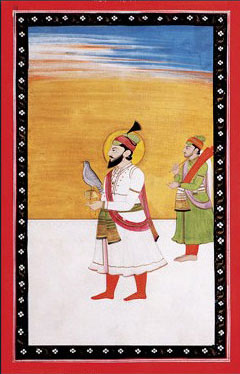
The
Guru realised that his son now possessed all the qualities required of a worthy
successor, recognising in him a total willingness to submit himself to the will
of God. Joyfully he told the Brahmans to present the following challenge to Aurangzeb:
'Our master and guide is Tegh Bahadur of noble Kshatriya descent. If the emperor
can persuade him to become a Muslim then we too shall convert to Islam. If, however,
he refuses, then we should be freed from the obligation to do so.'
The delegation
hastened with all possible speed to present this message to
Zalam Khan, Governor
of the Punjab.
The Guru's challenge was duly communicated to Aurangzeb, who
greeted it with expectant pleasure and gave orders for the Guru to be conducted
to Delhi with all honour. This, however, was not in accordance with the Guru's
own plans. He announced that he would make his own way to Delhi and Aurangzeb,
having been assured that the Guru's word could be trusted,permitted him to do
so.
According to Gian Singh's account Guru Tegh Bahadur followed a circuitous
route, visiting his sangats along the way. Eventually he reached Delhi and in
the hope that he might be intimidated he was there imprisoned in a mansion believed
to be haunted. Needless to say, the Guru was in no way disconcerted, nor was he
persuaded by any effort, which the emperor might make to convert him. Drawing
on his own vivid imagination, Gian Singh considerably expands the received tradition
with purported conversations between Guru and emperor. Blandishment and threats
were both tried, and both failed. The execution of the Guru 's personal attendants
likewise failed to intimidate him. The Delhi drama moved to its tragic, triumphant
climax.
That evening a proclamation was read in the city announcing that Guru Tegh Bahadur, the Hindu pir, would be executed the following morning at 7.30 a.m. The execution was to take place near the well in Chandni Chowk and all that wished to witness it were welcome to do so. Dread gripped the Sikhs of Delhi when they heard this announcement. Among those affected by the news was Bhai Jawahar Mal Arora, who had arrived in Delhi on business that very day, having vowed to give the Guru five hundred rupees. He managed to persuade Abdul the jailer to let him visit the divine Guru, and the Guru, after accepting his offering, distributed the entire sum to the needy. After darkness had fallen the same Sikh brought a feast of many different kinds of food. Appreciating this expression of love, the Guru shared the food with his followers and gave comfort to the generous donor. The Sikhs who were with him remained awake all night singing hymns.
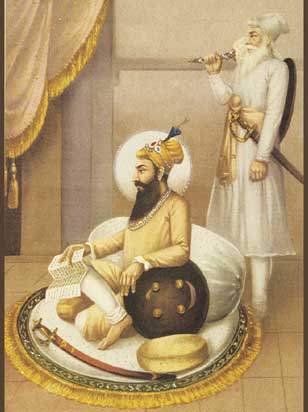
The actual execution took place on Thursday, 11 November 1675. Having bathed at the usual hour, the Guru spent some time singing devotional songs. The heavens wept as grief-stricken Sikhs assembled for the final act in the tragedy. The Guru himself, however, remained serene. The royal qazi came and for the last time offered him the choice of conversion or death. His reply left the issue in no doubt.
When the qazi reported his clear and defiant answer to Aurangzeb the enraged emperor immediately ordered the chief executioner, Saiyyid Jalaluddin, to make preparations for the beheading of the Guru. The sight struck terror in the hearts of the people who observed what was happening. When the Guru, having completed five recitations of Japji Sahib, bowed his head to meditate on God the brutal Saiyyid from Samana struck him with a sword so sharp that his head was completely severed from his body. The assembled crowd shuddered and uttered a horrified groan. Then darkness fell and an earthquake rocked the city. Fresh green trees wilted in despair. Shouts of triumph were heard from heaven and cries of lamentation from the earth ... Good men, both Hindu and Muslim, gave vent to their grief. Some wailed in anguish, some wrung their hands, some angrily called down vengeance on Aurangzeb.
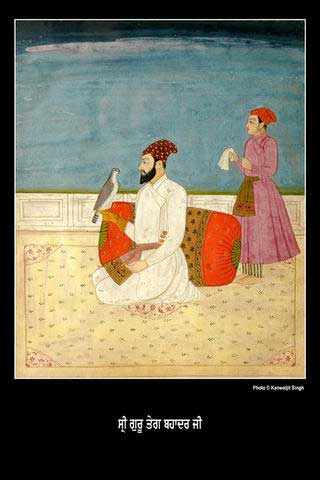
Guru Teg Bahadur (courtesy Prof Balwinder Singh)
Below Guru Teg Bahadur Ji's supposedly original painting (courtesy Prof Balwinder Singh)
